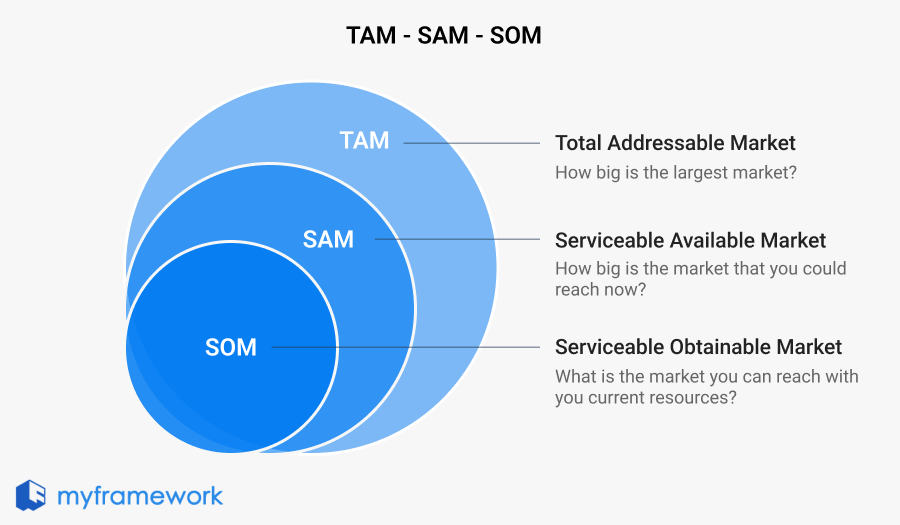Have you ever wondered how businesses identify the potential of a market and segment it effectively? The TAM-SAM-SOM model helps companies do just that.
Developed by marketing and business strategists, this framework allows organizations to better understand and measure the opportunity within a market.
Core Concept of TAM-SAM-SOM Analysis

The model divides the market into three categories:
- Total Addressable Market (TAM)
- Serviceable Available Market (SAM)
- Serviceable Obtainable Market (SOM)
Each with a different level of market potential. Now let’s dive into it.
TAM (Total Addressable Market)
This is the broadest category and represents the total demand for a product or service within a market. It is the ideal scenario where a company has 100% market share and is serving every possible customer.
Key Questions for Defining TAM
- What is the total size of the market globally or regionally?
- What is the overall demand for this product or service?
- How many potential customers exist, regardless of product availability?
- What are the long-term trends driving the market’s growth?
SAM (Serviceable Available Market)
SAM is a more realistic view of the market. It narrows down the TAM to only those customers who are reachable based on geography, regulations, capabilities or resources.
Key Questions for Defining SAM:
- Which geographic areas can I serve with my product or service?
- What specific customer groups can I realistically target based on current capabilities?
- What are the legal, regulatory, or cultural barriers preventing access to certain customers?
- How does my offering meet the needs of this specific market?
SOM (Serviceable Obtainable Market)
SOM is the most specific category. It represents the portion of the SAM that your business can realistically capture, given your resources, competition, and market position.
Key Questions for Defining SOM:
- What is the current competition in this segment, and what is their market share?
- What portion of the market can I realistically reach in the next 6 to 12 months?
- What resources (financial, human, or technological) do I have to capture this market?
- How can I differentiate my offering to stand out in this specific segment?
Examples of How to Conduct This Model
Example 1: Smartphone Company
- TAM: The total global smartphone market size, which might be in the billions, representing every single person who might consider purchasing a smartphone, whether they already own one or not.
- SAM: If your smartphone is only available in North America, your SAM would focus on the population within North America, including factors like age, income, and technological adoption.
- SOM: As a new smartphone brand, your SOM would focus on a smaller group within your SAM, say 10% of the North American market, accounting for your brand’s competitive position, marketing reach, and consumer preferences.
Example 2: SaaS Business Solution
- TAM: The entire global market for cloud-based SaaS solutions, including businesses of all sizes across different industries.
- SAM: Your software may only be suited for small-to-medium businesses in the financial sector, so your SAM would include this group within a certain region (e.g., North America or Europe).
- SOM: Your SOM, given the competitive landscape, may be limited to small businesses in the U.S. that have a budget for cloud services and are looking for affordable financial software solutions, which would be a smaller portion of your SAM.
Unlock all frameworks and templates
Unlock exclusive thinking frameworks and practice templates.
Become a member to access all premium content to elevate your thinking!
Tips of Using the Model
- Focus on realistic goals: Start with understanding your TAM to get the big picture, but then focus on your SAM and SOM to set achievable and realistic market penetration goals.
- Update regularly: Market conditions change, and so should your analysis. Periodically revisit your TAM, SAM, and SOM to ensure your strategies align with current market realities.
- Use SOM for practical planning: While TAM gives you the ultimate potential, it’s your SOM that will guide short-term actions and help you prioritize efforts effectively.
By applying the TAM-SAM-SOM model, businesses can segment their markets more effectively, identify opportunities, and plan their strategies with a clearer focus on what is achievable.

